Choosing the right LED high bay temp lights is crucial for industrial and commercial spaces with high-temperature environments. These specialized fixtures offer superior illumination while withstanding extreme heat conditions.
At PacLights, we understand the importance of reliable lighting solutions in challenging settings. This guide will help you navigate the key factors to consider when selecting LED high bay temp lights for your facility.
What Are LED High Bay Temp Lights?
Definition and Purpose
LED high bay lights are specialized lighting fixtures designed to operate in high-temperature environments. These robust lights provide superior illumination for industrial and commercial spaces while withstanding extreme heat conditions.
Advantages of LED Technology
LED technology offers significant benefits for high-temperature settings. LEDs require considerably less power than traditional lighting, which also makes it difficult for those familiar with metal halide and HID technology to accurately compare them. This characteristic allows LED high bay temp lights to maintain their performance and longevity in challenging conditions.
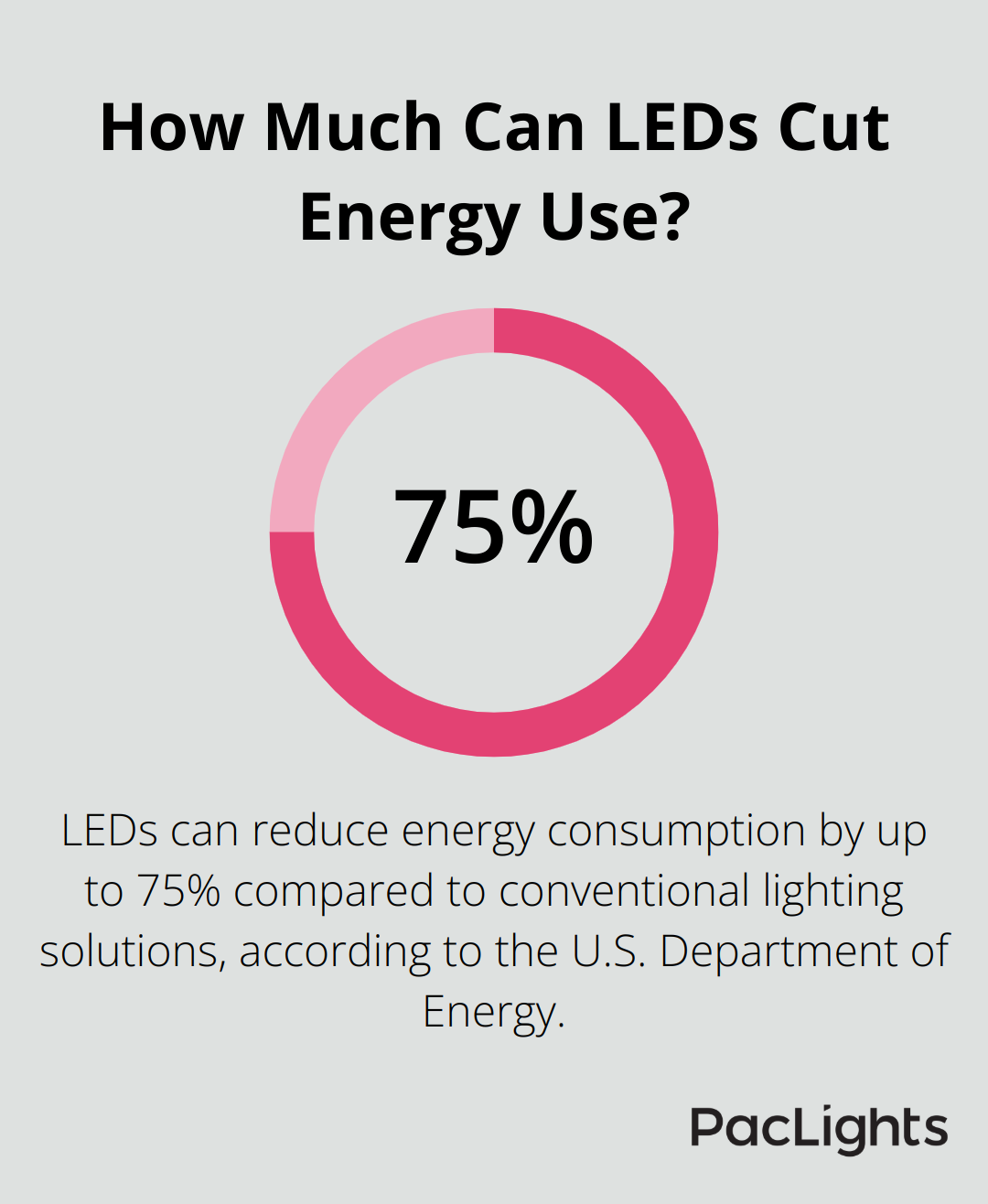
The U.S. Department of Energy reports that LEDs can reduce energy consumption by up to 75% compared to conventional lighting solutions. This efficiency translates to lower operating costs and reduced strain on cooling systems in high-temperature environments.
Key Features for Optimal Performance
Temperature Rating
High-quality fixtures should operate in temperatures up to 65°C (149°F) or higher, depending on your facility’s specific requirements.
Heat Dissipation
Look for lights with advanced thermal management systems, such as aluminum heat sinks or innovative cooling fins. These features help maintain optimal operating temperatures, ensuring the longevity and performance of the LEDs.
Illumination Quality and Efficiency
Lumen Output and Efficacy
Try to select fixtures that deliver high lumens per watt (typically 130 lumens per watt or more) to maximize energy efficiency without compromising brightness.
Color Temperature and Rendering
Color temperature and Color Rendering Index (CRI) play significant roles in illumination quality. For industrial settings, a color temperature of 5000K is often preferred as it mimics daylight and promotes alertness. A CRI of 80 or higher ensures accurate color representation, which is essential for quality control and safety in industrial environments.
Durability and Protection
Opt for LED high bay lights with high IP (Ingress Protection) ratings. An IP65 rating or higher indicates excellent protection against dust and water, which is essential for maintaining performance in harsh industrial conditions.
The next chapter will explore additional factors to consider when choosing LED high bay temp lights, including beam angle, light distribution, and energy efficiency.
What Factors Matter Most in LED High Bay Temp Lights?
Temperature Rating and Heat Management
The temperature rating of LED high bay lights is a top priority. For high-temperature environments, select fixtures rated to operate at 65°C (149°F) or higher. This ensures your lights withstand the heat without compromising performance or lifespan.
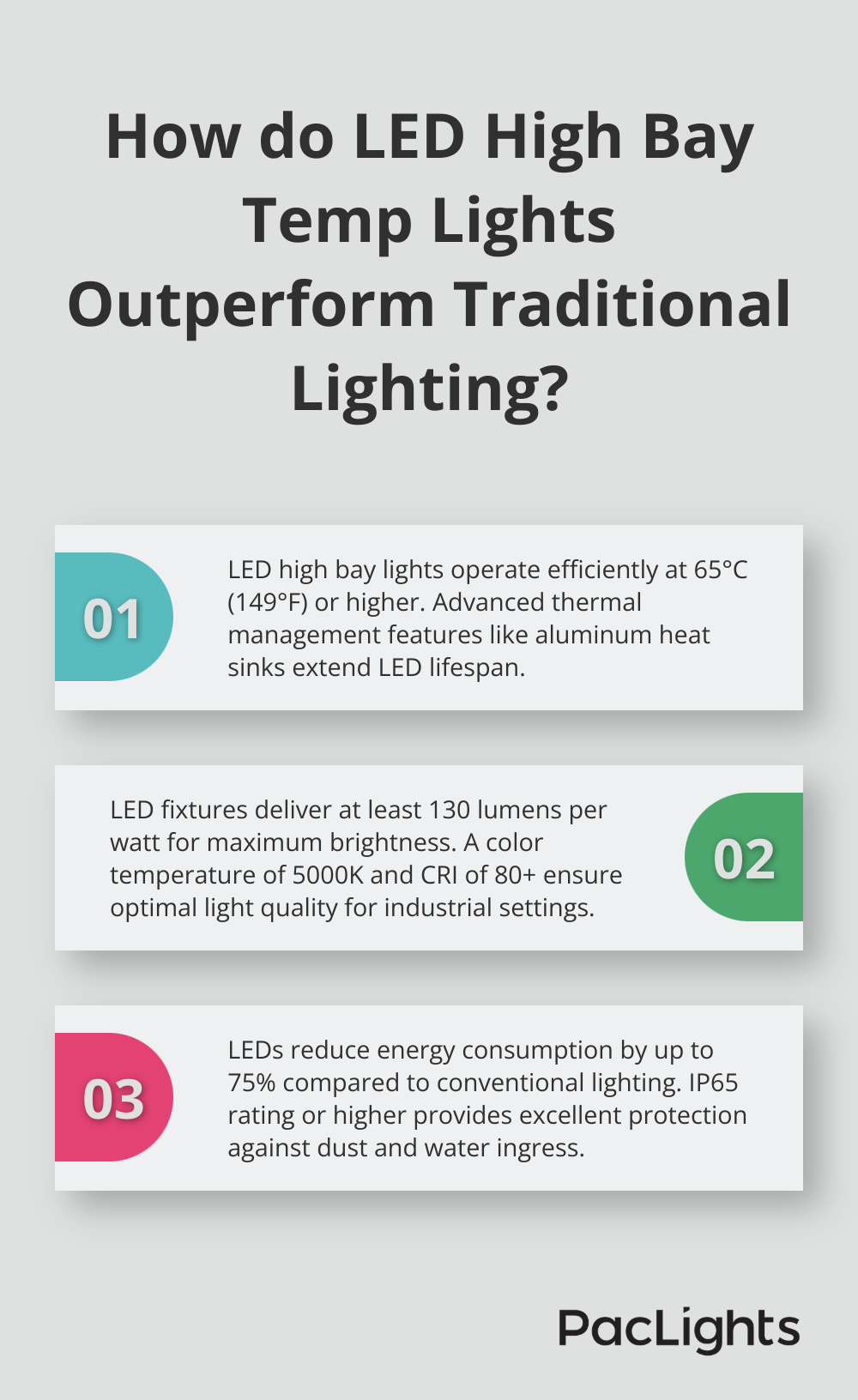
Heat dissipation systems are equally important. Advanced thermal management features (like aluminum heat sinks or innovative cooling fins) maintain optimal operating temperatures. These components extend the life of your LEDs and preserve their efficiency.
Light Output and Energy Efficiency
Both quantity and quality of illumination matter. Try to select fixtures that deliver at least 130 lumens per watt. This high efficacy provides maximum brightness while minimizing energy consumption.
Color temperature and Color Rendering Index (CRI) significantly impact light quality. For industrial settings, a color temperature of 5000K often proves ideal, as it mimics daylight and promotes alertness. A CRI of 80 or higher ensures accurate color representation, which is critical for quality control and safety in industrial environments.
The beam angle of your lights affects light distribution. Wide beam angles (120° or more) provide broader coverage, ideal for open spaces. Narrower beam angles (60° or less) offer more focused illumination, suitable for high-ceiling areas or specific task lighting needs.
Durability and Protection
In harsh industrial environments, lights must withstand more than just heat. Select fixtures with high Ingress Protection (IP) ratings. An IP65 rating or higher indicates excellent protection against dust and water ingress, ensuring your lights maintain performance even in challenging conditions.
Energy Savings and Cost Considerations
The U.S. Department of Energy reports that LEDs reduce energy consumption by up to 75% compared to conventional lighting solutions. This efficiency translates to significant cost savings over time. When evaluating different options, consider the total cost of ownership, including energy consumption and maintenance needs, not just the initial purchase price.
Some manufacturers offer advanced features like optional daylight or motion controls. These features further optimize energy use, potentially increasing your savings. For example, lights that automatically dim or turn off when not needed substantially reduce energy waste.
Advanced Features and Customization
LED high bay temp lights often come with additional features that enhance their functionality. Look for options like adjustable color temperatures, which allow you to fine-tune the lighting to your specific needs. Some manufacturers also offer customizable beam angles, enabling you to tailor the light distribution to your space’s layout.
The next chapter will explore installation and maintenance considerations for LED high bay temp lights, ensuring you get the most out of your investment.
How to Install and Maintain LED High Bay Temp Lights
Proper Mounting and Positioning
Install LED high bay temp lights at least 15 feet above the floor. Space fixtures 1 to 1.5 times the mounting height apart. Use heat-resistant mounting hardware (such as stainless steel or high-grade aluminum brackets) in high-temperature environments. Secure all mounting points to prevent vibration and premature failure.
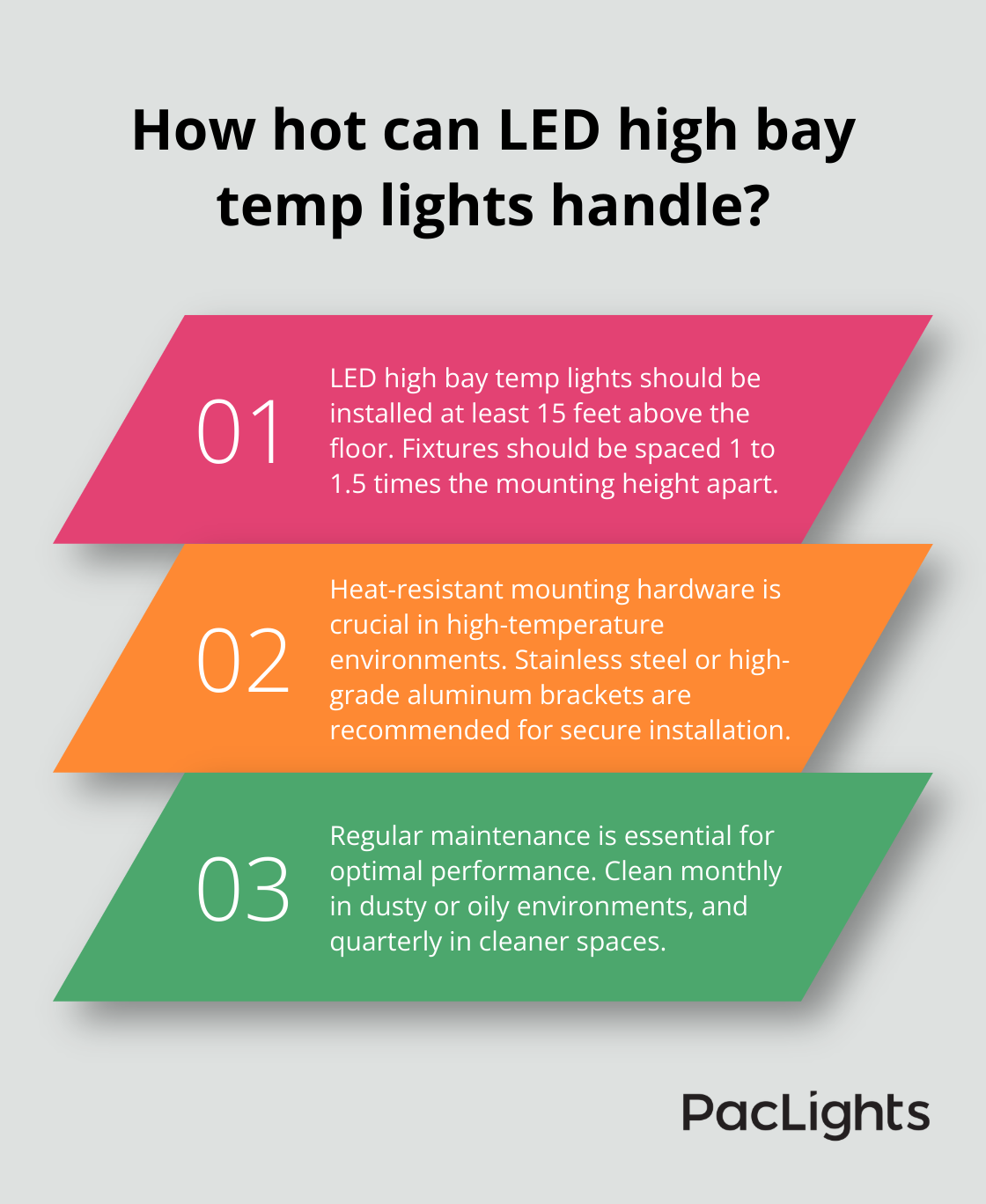
Position lights to minimize shadows and glare. Adjust placement in areas with machinery or tall shelving to avoid dark spots. Use light meters to verify uniform illumination across your workspace.
Electrical Considerations
Use high-temperature rated cables and connectors suitable for your environment. Follow the National Electrical Code (NEC) guidelines for wiring in industrial settings. Install surge protectors to safeguard LED fixtures from power spikes. Consider implementing a dedicated circuit for your high bay lighting to isolate it from other electrical systems.
For dimming capabilities, ensure your controls are compatible with the LED drivers in your fixtures. Incompatibility can lead to flickering or premature failure.
Effective Maintenance Procedures
Establish a cleaning schedule based on your facility’s conditions. Clean monthly in dusty or oily environments, and quarterly in cleaner spaces. Use a soft, dry cloth to remove dust and debris. For stubborn grime, use a slightly damp cloth with a mild, non-abrasive cleaner. Always clean cool, powered-off lights.
Inspect fixtures regularly for signs of heat damage (discoloration or warping). Check and tighten all electrical connections. Replace damaged parts immediately to prevent further issues.
Troubleshooting Common Issues
Address flickering by checking power supply, driver, and connections. Ensure stable voltage. Replace the driver if the issue persists.
For dimming problems, verify that your system is designed for LED use and properly connected. Some LED drivers require a minimum load to function correctly – meet this requirement.
If a fixture fails completely, check the power supply and connections first. The issue may be with the LED chips or driver if these are intact. In high-temperature environments, consider upgrading to a higher temperature-rated model if premature failure occurs repeatedly.
LED high bay temp lights play a vital role in industrial and commercial spaces with high-temperature environments. These fixtures combine temperature ratings, heat dissipation, lumen output, color quality, and durability to ensure optimal performance in challenging conditions. Quality and performance are essential in industrial lighting, as subpar fixtures can increase downtime, safety risks, and operational costs.
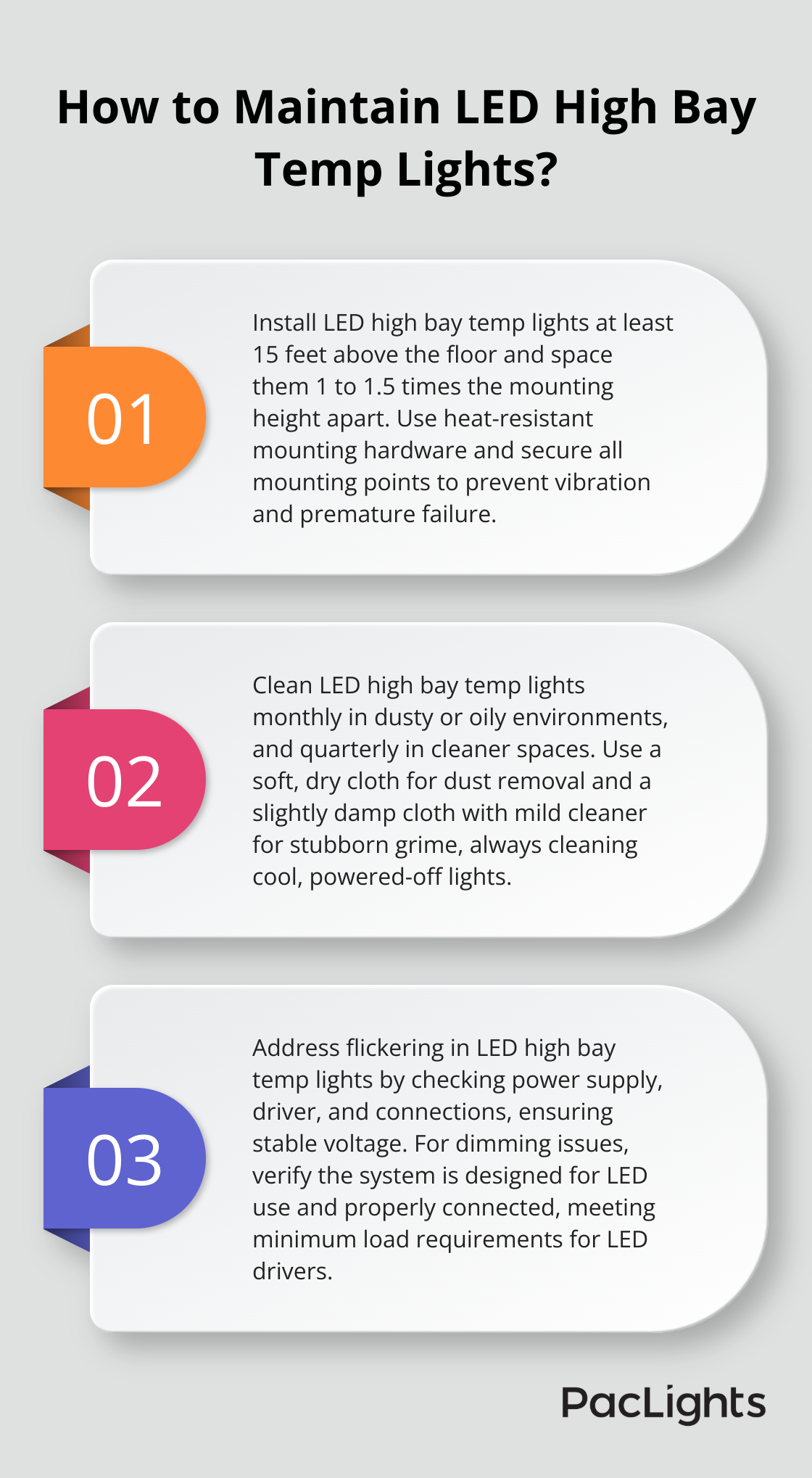
The long-term benefits of choosing the right LED high bay temp lights are significant. Energy savings of up to 75% compared to traditional lighting result in substantial cost reductions over time. Improved light quality and distribution create a safer, more productive work environment, while durability and longevity reduce replacement and maintenance costs.
We at PacLights understand the unique challenges of industrial lighting. Our LED high bay temp lights are designed to meet the demanding requirements of high-temperature environments (with features like advanced thermal management and high lumen output). The right lighting solution is an investment in your facility’s efficiency, safety, and bottom line.


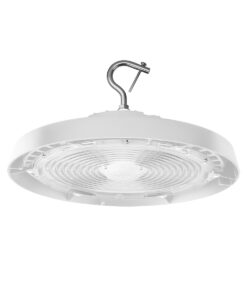


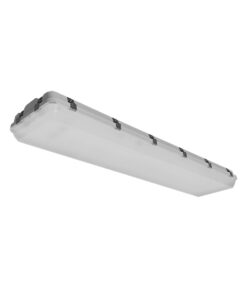
Disclaimer: PacLights is not responsible for any actions taken based on the suggestions and information provided in this article, and readers should consult local building and electrical codes for proper guidance.